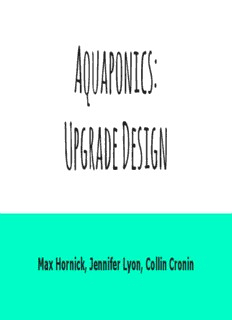
Aquaponics: Upgrade Design - wmich.edu PDF
Preview Aquaponics: Upgrade Design - wmich.edu
Aquaponics: Upgrade Design Max Hornick, Jennifer Lyon, Collin Cronin What Will We Learn Today? ● Aquaponics Basics ● Design Criteria ● Fish Species ● Filtration ● Hydroponic Systems ● What’s Next ● Conclusion Aquaponics : How it Works Aquaponics = Aquaculture + Hydroponics (farmXchange, 2015) Design Criteria Design goal: Upgrade the aquaponics system to test new design concepts before constructing a hoop-house system at the Gibbs Farm. Criteria: ● Durable & low maintenance ● High efficiency & productivity ● Adaptable, simple troubleshooting & parts replacement ● Demonstrate potential for outdoor and commercial systems in Michigan Fish Species: Yellow Perch Based on a 2% feed rate and the size of our system, we will purchase 40 fish from Laggis' Fish Farm in Gobles, MI. Benefits of yellow perch: ● Tolerate poor water quality ● Native to Michigan ● Reproductive reliability (Kansas Wildlife Federation, 2014) Mechanical Filtration A radial flow separator (RFS) is made of common materials. A RFS redirects water flow and uses gravity to provide efficient mechanical filtration of heavy waste solids. Benefits of the RFS: ● Relatively cheap DIY build ● Better solids capture than swirl/vortex filters ● Accessible materials (WMT, 2015) Biofiltration: Sand and Gravel Filter Sand and gravel filters use a slow flow rate and a high surface area of gravel and sand to create ideal conditions for the growth of the bacteria culture that converts ammonia into nitrate. Benefits of sand and gravel filters: ● Relatively cheap DIY build ● Superior biofiltration ● Accessible materials (Living Water Solutions, 2015) Hydroponic Systems: Deep Water Culture In a deep water culture (DWC) system, plants grow in rafts floating over a pool of aerated water. Benefits of this DWC design: ● Will not clog with solids ● Easy access for troubleshooting ● Relatively cheap DIY build ● Safety, durability, and ease of sanitation (Tucson AquaPonics Project, 2015) Hydroponic Systems: Vertical Towers Vertical tower systems grow plants in towers with water running down them. Benefits of this tower design: ● Optimizes space ● Cost effective ● Performs nitrification, solids filtration, and mineralization What’s Next? ● Hire and train new teammate ● Upgrade and maintain new system ● Monitor system data to assess design concepts ● Adapt system as needed for optimal production ● Create revised design for Gibbs Farm hoop-house system
Description: